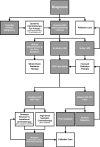Leptomeningeal disease: current diagnostic and therapeutic strategies
- PMID: 29069871
- PMCID: PMC5641214
- DOI: 10.18632/oncotarget.20272
Leptomeningeal disease: current diagnostic and therapeutic strategies
Abstract
Leptomeningeal disease has become increasingly prevalent as novel therapeutic interventions extend the survival of cancer patients. Although a majority of leptomeningeal spread occurs secondary to breast cancer, lung cancer, and melanoma, a wide variety of malignancies have been reported as primary sources. Symptoms on presentation are equally diverse, often involving a combination of neurological deficits with the possibility of obstructive hydrocephalus. Diagnosis is definitively made via cerebrospinal fluid cytology for malignant cells, but neuro-imaging with high quality T1-weighted magnetic resonance imaging can aid diagnosis and localization. While leptomeningeal disease is still a terminal, late-stage complication, a variety of treatment modalities, such as intrathecal chemotherapeutics and radiation therapy, have improved median survival from 4-6 weeks to 3-6 months. Positive prognosticative factors for survival include younger age, high performance scores, and controlled systemic disease. In looking to the future, diagnostics that improve early detection and chemotherapeutics tailored to the primary malignancy will likely be the most significant advances in improving survival.
Keywords: intrathecal chemotherapy; leptomeningeal carcinomatosis; leptomeningeal disease; neoplastic meningitis; radiation therapy.
Conflict of interest statement
CONFLICTS OF INTEREST None.
Figures
References
-
- Youmans JR, Winn HR. Youmans neurological surgery. Philadelphia, PA: Saunders/Elsevier; 2011. p. 4. v. (xci, 4206, xci p)
-
- Chowdhary S, Chamberlain M. Leptomeningeal metastases: current concepts and management guidelines. J Natl Compr Canc Netw. 2005;3:693–703. - PubMed
Publication types
LinkOut - more resources
Full Text Sources
Other Literature Sources



